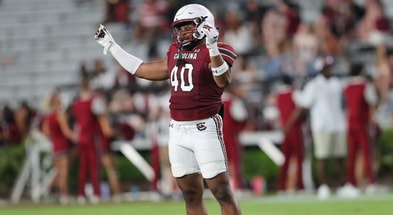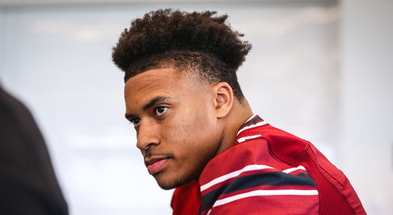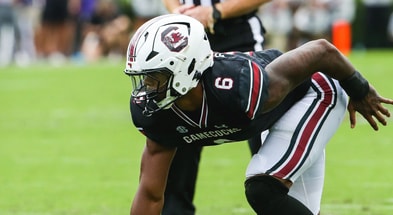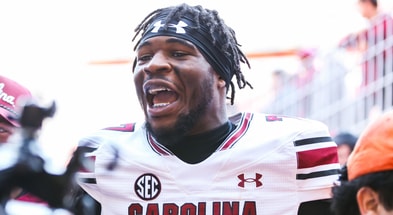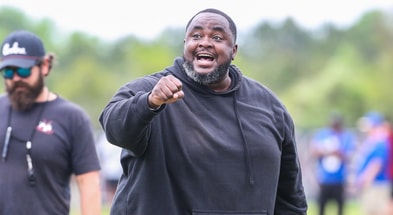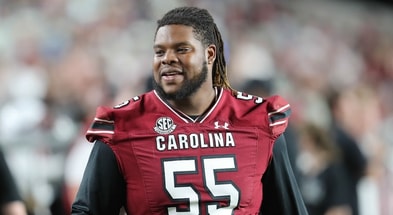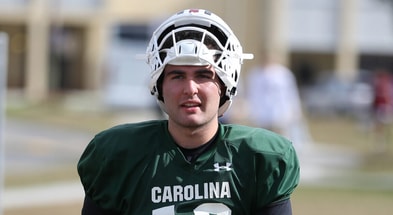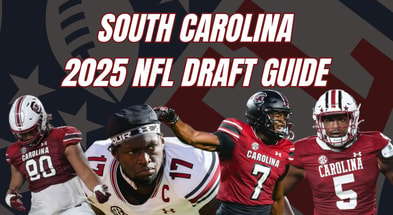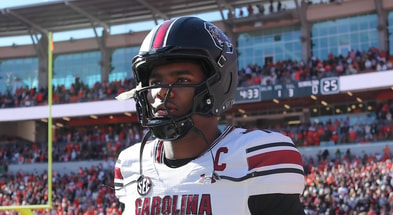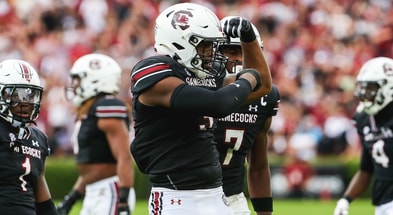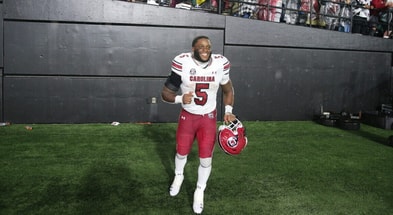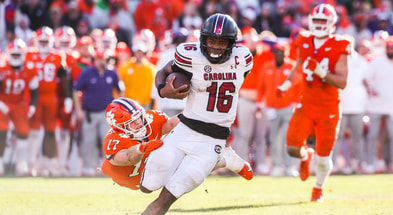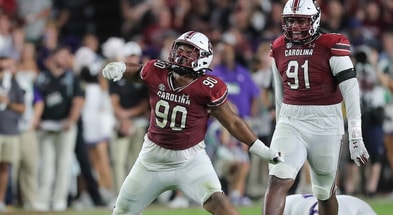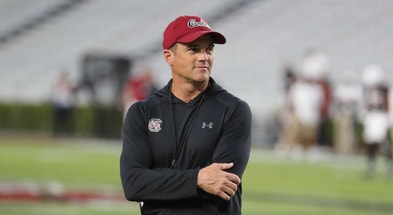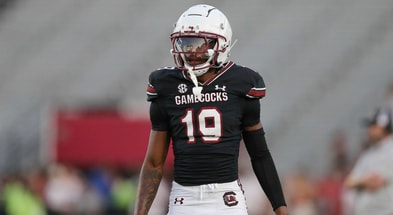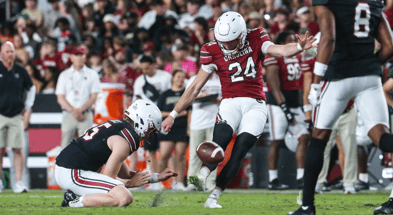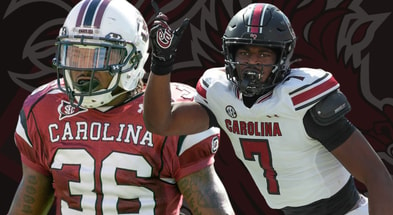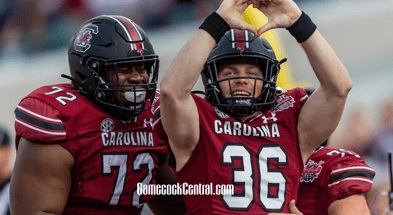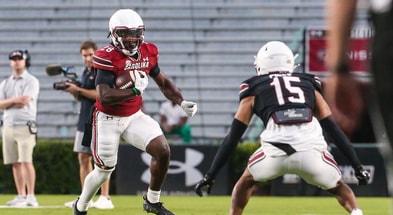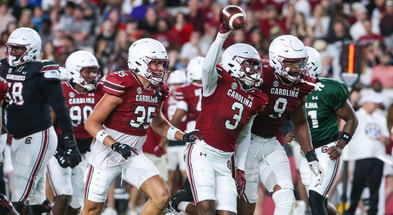The Top 10 running backs in Gamecock history: Revisiting a conversation with Tommy Moody

Alan Piercy is the author of A Gamecock Odyssey: University of South Carolina Sports in the Independent Era (1971-1991). The following was originally published on Alan’s South By Southeast newsletter.
Revisiting a conversation with the late, great Tommy Moody
Like many, I got the news on a Tuesday night in mid-October last year. After embarking upon a few minutes of mindless social media scrolling before lights out, I ran across a Twitter/X post from Jay Philips of Columbia’s 107.5 The Game that broke the horrible, unbelievable news.
Tommy Moody had passed.
I had spoken with Tommy just four days prior when he graciously invited me to chat with him on his long-running program, “The Tommy Moody Show,” where we talked about the greatest Gamecock running backs of all time. He was vibrant and energetic and consumed by the conversation.
Just the day before, Tommy had texted me photos and a video of him presenting a commemorative plaque to former Gamecock baseball coach Bobby Richardson at the prior week’s University of South Carolina Athletics Hall of Fame ceremony. He had a way of doing things like that that let you know he was thinking of you, even amidst the bustle of his busy life.
Seeing Jay’s post, I lay there in disbelief and profound sadness. What a loss. What a man.
Life has a way of giving and taking away unexpectedly. Tommy had come into my life just a few weeks earlier after hearing about my upcoming book covering Gamecock history. It was a topic right up his alley, and he invited me on a series of his radio shows to talk about it.
He was generous and kind, eager to support the book, and beset by a boyish enthusiasm that set me immediately at ease. He possessed a radiant intellect and a searing love for all things Garnet & Black that drew fellow travelers into his orbit with an irresistible magnetic pull.
Though neither of us could have known it then, our conversation of Oct. 13, 2023, marked the final episode of the Tommy Moody Show. Even a year later, his loss to the Gamecock community feels immense.
As I recently revisited a piece I wrote summarizing that conversation, it brought a smile to my face, and my hope is it will do the same for other GamecockCentral readers.
Godspeed, Tommy, and thank you, my friend.
Friday, Oct. 13, 2023
Earlier today, the great Tommy Moody graciously invited me to join him on “The Tommy Moody Show” for a conversation around the top 10 greatest running backs in Gamecock football history. It was a difficult homework assignment.
Top 10 lists are notoriously subjective and controversial. Clickbait “best-of” lists litter the internet like highway trash after a stiff wind. Even so, these lists are irresistible and fun and fodder for broader conversation. We both took it seriously, putting in quite a bit of research in an earnest effort to recognize the top 10 greatest ball carriers to ever don a Gamecock jersey.
We agreed on much, but not everything. Despite my best efforts, I realized that my list, in particular, suffered from recency bias. I had personally witnessed nine of my top 10 play in person since I started going to games as a kid in 1980. No doubt, there were those who deserved inclusion from earlier decades. Such is the peril of lists like this. But it was a fun exercise, nonetheless.
[Join GamecockCentral for fast, accurate, and in-depth coverage of Gamecock sports and recruiting]
The List
10. (Alan & Tommy) – Kevin Harris: Tommy and I agreed right out of the gate on this one. Harris was one of the real bright spots of the Will Muschamp era. Harris played three seasons in a Gamecock uniform (2019-21), but what really thrust him into the conversation was his sensational performance during the COVID-altered season of 2020. His single-season total of 1,138 yards in 2020 is the fifth-best in program history. He ground out 6.2 yards per carry during that season, tied for eighth best in program history. His 15 rushing touchdowns that year are second only to Marcus Lattimore’s 17 during his sensational freshman season of 2010. Moreover, Harris is the career leader in rushing average, an astounding 6.4 (206 attempts for 1,317 yards) – the only running back in program history to average over 6 yards per carry (1,000-yard minimum) during a career.
9. (Alan) – Mike Davis: Davis, (2012-14), hailed from Lithonia, Georgia in the sprawling suburbs east of Atlanta. Not to be confused with the earlier Mike Davis (2005-08), who was also a very good running back, the latter Davis was Carolina’s go-to back during two of the most successful seasons in program history, 2012 and 2013. He owns the fourth-highest single-season rushing total (1,183) from 2013, and his 11 rushing touchdowns that same season are tied for seventh. His 19 career rushing touchdowns are tied for 10th best. He was a physical, punishing back, and earned All-SEC second team honors in 2013, his finest season at Carolina.
(Tommy) – Cory Boyd: From Orange City, New Jersey, Boyd racked up 2,267 yards for the Gamecocks between 2003-07, good for 12th in program history. He was a mainstay of the late Holtz and early Spurrier eras. Simply put, this guy had moves. He was one of the most evasive backs in recent memory, but he could also run over defenders. Check out a compilation of Boyd’s highlights here.
8. (Alan) – Duce Staley: From West Columbia’s Airport High School by way of Itawamba Community College in Mississippi, Staley (1995-96) enjoyed a stellar two seasons after transferring to Carolina in 1995. He owns the seventh-highest single season rushing total (1,116), and was at the time the most productive running back at Carolina since Heisman Trophy winner George Rogers in 1980. Staley had nine 100-plus yard performances in his career, good for sixth in program history. Named a first-team all-SEC performer in 1996, he was Carolina’s first all-conference first-team running back since Warren Muir (ACC) in 1969.
(Tommy) – Kent Hagood: From Easley, South Carolina, Hagood (1981-85) was a bruiser with the body of a fullback and the speed of a sprinter. He was the brother of nose guard Rickey Hagood (1980-83). The younger Hagood, along with backfield mate Thomas Dendy, fueled an exciting running attack during the “Black Magic” season of 1984, which saw the Gamecocks rise to No. 2 in the polls after a 9-0 start and finish with the program’s first-ever 10-win season. Hagood ran for 2,014 yards on 365 carries during his career, a 5.5-yard average, good for fourth place in program history.
7. (Alan & Tommy) – Thomas Dendy: From Hillcrest High School in Simpsonville, South Carolina, Dendy (1982-85) is the program’s fifth all-time rushing leader with 2,767 yards. He led the team in rushing during all four seasons despite a bevy of talented running backs at the time, including the likes of Kent Hagood, Quinton Lewis, Todd Berry, and Raynard Brown. His eight career 100-plus yard rushing games are tied for fifth-best. Dendy was elected to the USC Athletics Hall of Fame in 2012.
6. (Alan) – Johnnie Wright: To fully grasp how good Wright was during his years at Carolina (1977-81), consider that he was starting at tailback ahead of future Heisman winner George Rogers during their freshman and sophomore seasons of 1977 and 1978. It wasn’t until Wright suffered a pre-season knee injury in 1979 that Rogers was thrust from the fullback position into the tailback slot, and from there, the rest is history. But Wright was a brilliant back in his own right. He is fourth all-time in rushing attempts (552) and owns six 100-plus yard games. Perhaps most notably, he ran for 115 yards in Carolina’s upset of No. 3-ranked UNC in Chapel Hill during the 1981 season.
Top 10
- 1New
Donald Trump blasts NFL
Teams for not drafting Sheduer Sanders
- 2
Jaden Rashada
Makes transfer commitment
- 3
Kim Mulkey
Takes victory lap on South Carolina
- 4Hot
2nd Round NFL Mock Draft
QBs under microscope
- 5
Shedeur Sanders reacts
To going undrafted in 1st round
Get the On3 Top 10 to your inbox every morning
By clicking "Subscribe to Newsletter", I agree to On3's Privacy Notice, Terms, and use of my personal information described therein.
(Tommy) – Mike Davis (see No. 9 above)
5. (Alan & Tommy) – Harold Green: From Stratford High School in Ladson, South Carolina, Green (1986-89) is the third all-time rushing leader at USC, with 3,005 career yards – one of only three backs to rush for over 3,000 yards. Green played during the pass-happy “Run & Shoot” years, with quarterback Todd Ellis under center, breaking nearly every passing record in the book. Green provided a counterbalance to that passing attack and a grind-it-out toughness that allowed Ellis to flourish. Green is second in rushing touchdowns (31), tied with Heisman winner Rogers, and behind only Marcus Lattimore. He is tied for second with 11 100-plus yard rushing games and was named All-South Independent in both 1987 and 1989. Green was elected to the USC Athletics Hall of Fame in 2012.
4. (Alan) – Steve Wadiak: Simply put, Wadiak is a legend at South Carolina and owns the best nickname in program history (“The Cadillac”). Wadiak played for coach Rex Enright from 1948-51, and his exploits astound even today, some 60-plus years after he dominated the Southern Conference. He is still fourth all-time in career yardage (2,878), and owns 10 100-plus yard rushing games, including an astounding 256 yard performance versus highly-ranked Clemson in 1950. He was named All-Southern Conference in both 1950 and ‘51. Wadiak was the subject of Mike Chibarro’s excellent book, The Cadillac. He was inducted into the USC Athletics Hall of Fame in 1967. His No. 37 was the first number retired in any sport at USC.
(Tommy) – Brandon Bennett (see below)
3. (Alan) – Brandon Bennett: Bennet (1991-94), out of Greenville, South Carolina, will forever be beloved by Gamecock fans for one of the most memorable plays in program history. His last-second plunge over the top in Sanford Stadium to start the 1993 season – just Carolina’s second season in the mighty Southeastern Conference – secured an unlikely 23-21 win for the Gamecocks, inspiring one of the iconic radio calls in Gamecock history, both from Georgia’s legendary broadcaster Larry Munson and the “Voice of the Gamecocks,” Bob Fulton. But Bennett’s career accomplishments speak to his greatness beyond that bronze-cast moment in Athens. He is the program’s second all-time leading rusher (3,055) and owns the top single-game rushing performance with 278 yards versus East Tennessee State on Oct. 5, 1991. His 11 100-plus yard rushing performances are tied for second-most, behind only George Rogers.
(Tommy): Steve Wadiak (see above).
2. (Alan & Tommy) – Marcus Lattimore: Hailing from Duncan, South Carolina, Marcus Lattimore was one of the most heralded recruits of the Steve Spurrier era and program history. Named “Mr. Football” in South Carolina following his senior season at James F. Byrnes High School in 2010, Lattimore chose South Carolina over Auburn on national signing day. His career at South Carolina was a brilliant one, cut short though it was by two devastating knee injuries, which ended his sophomore and junior campaigns after seven and nine games, respectively.
Though he only played one full season with the Gamecocks, Lattimore left as the program leader in rushing touchdowns (38) on 399 fewer carries than previous leader Rogers (31). Lattimore earned SEC Freshman of the Year, first-team all-SEC, and second-team All-America honors following the 2010 season. His 40 carries versus Florida that season is a single-game record, as the Gamecocks rode Lattimore to a dominant 38-14 win in Gainesville, securing the program’s first and still only SEC East championship. Lattimore was inducted into the USC Athletics Hall of Fame in 2019.
1. (Alan & Tommy) – George Rogers: There is no debate when pondering the single greatest running back in program history. Consider that Rogers’ program record of 5,204 rushing yards is 2,149 more than second-place Brandon Bennett’s 3,055. That 2,149-yard difference would be good for 16th best in program history – ahead of program stalwarts like Kent Hagood, Duce Staley, and Stanley Pritchett, among others. Rogers holds three spots in the top 11 single-season rushing totals, including the two top spots (1980 and 1979). No other Gamecock player has multiple entries in that category.
From Duluth, Georgia, Rogers also holds the record for rushing attempts in a career (954) and season (324 in 1980), a testament to his consistency and durability. He holds the record for 100-plus yard rushing games with 27 – more than doubling the four-way tie of Bennett, Green, Lattimore, and Davis with 11 each in second place. His career and season all-purpose marks of 5,932 and 1,917 (1980), respectively, are also program standards.
But more than the records, some of which are likely never to be broken, Rogers brought pride and legitimacy to a program that had been mostly mired in mediocrity throughout its long football history. He showed that the University of South Carolina could compete with the blue bloods of college football. He was a lovingly adopted son who captured the hopes and imagination of an entire state.
Rogers famously won the Heisman Trophy in 1980, becoming the first Black player from the South to do so, followed soon after by Hershel Walker of Georgia and Bo Jackson of Auburn, among others. He was the No. 1 overall pick in the 1981 NFL draft (New Orleans) and later helped Washington to a Super Bowl victory in 1987 in his final professional game. Rogers was elected to the USC Athletics Hall of Fame that same year.
Honorable Mention(s)
There were others, of course, who were deserving of conversation. Top 10 lists are inherently maddening in that they do not allow for 11, 15, or 20 names. Carolina football has been blessed with talent at the running back position. We talked about greats like Jay Lynn Hodgin (1972-74), Warren Muir (1967-69), Rob DeBoer (1990-93), Kevin Long (1973-76), Clarence Williams (1974-76), and Rico Dowdle (2016-19), among others.
I even suggested Connor Shaw (2010-13), Carolina’s winningest quarterback, who gained 1,683 yards rushing during his career, the only quarterback in the top 25 all-time rushing list. It was a bit of a cheat, and Tommy stood on principle, only including true running backs.
There is no perfect top 10 list. There are too many variables, different eras, different styles of play, too much tendency, perhaps, toward recency bias. But we gave it our best shot.

